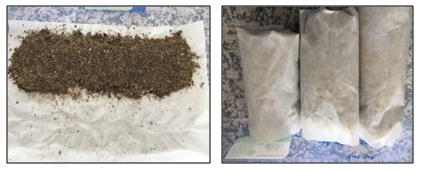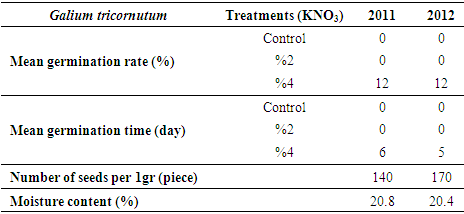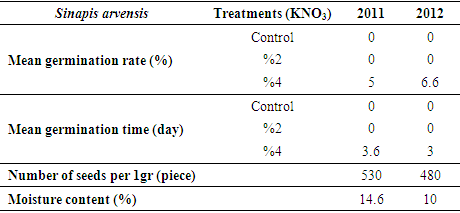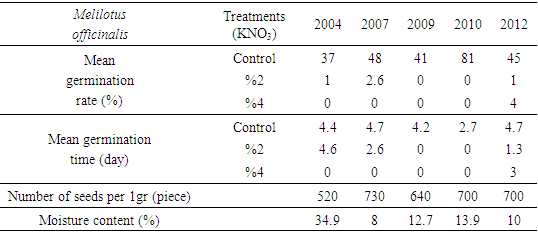-
Paper Information
- Paper Submission
-
Journal Information
- About This Journal
- Editorial Board
- Current Issue
- Archive
- Author Guidelines
- Contact Us
International Journal of Agriculture and Forestry
p-ISSN: 2165-882X e-ISSN: 2165-8846
2019; 9(2): 61-66
doi:10.5923/j.ijaf.20190902.03

The Effects of Different Priming Treatments on Germination Rates of Some Winter Weed Seeds
Derya Öğüt Yavuz1, Burcu Begüm Kenanoğlu2
1Usak University Agriculture and Natural Science Faculty, Plant Protection Department, Usak, Turkey
2Usak University Agriculture and Natural Science Faculty, Horticulture Department, Usak, Turkey
Correspondence to: Derya Öğüt Yavuz, Usak University Agriculture and Natural Science Faculty, Plant Protection Department, Usak, Turkey.
| Email: |  |
Copyright © 2019 The Author(s). Published by Scientific & Academic Publishing.
This work is licensed under the Creative Commons Attribution International License (CC BY).
http://creativecommons.org/licenses/by/4.0/

Priming is a different application to the seed prior to seeding with controlled water in take to accelerate the metabolic activity that will ensure the germination of the seed. Especially in unfavorable conditions such as low temperature; germination and emergence rate, seedling production which increases the speed of the desired density in a short time provides. Factors which necessary for germination contains temperature, nutrients, light, moisture and gases ratio. In this study was to determine the germination capacity of the seeds of different ages such as Galium tricornutum Dandy, Sinapis arvensis L., Melilotus officinalis L. with different priming and cold stratification processes. Methods used for this purpose; at 30-20°C (7/17 hours, day/night), halopriming with 2-4 % KNO3 and cold stratification for 10 days at + 4°C - 25°C for 1 month. In this study; seed moisture content (%), normal abnormal germination rate (%) and mean germination time (days) were determined. The moisture content of the seeds used was determined between 8-35%. Germination was determined in M. officinalis seeds by halopriming and cold stratification applications. The highest germination rate was observed in M. officialis species at age 7 but the highest abnormal germinations rates taken from G. tricornutum at age 5 and S. arvensis at age 11.
Keywords: Galium tricornutum, Sinapis arvensis, Melilotus officinalis, Priming, Cold stratification
Cite this paper: Derya Öğüt Yavuz, Burcu Begüm Kenanoğlu, The Effects of Different Priming Treatments on Germination Rates of Some Winter Weed Seeds, International Journal of Agriculture and Forestry, Vol. 9 No. 2, 2019, pp. 61-66. doi: 10.5923/j.ijaf.20190902.03.
1. Introduction
- Weeds are unwanted factors that competes with cultivated plants in terms of water, light and nutrient and reduces the yield and quality of cultivated plants when their development is not suppressed (9; 1). In Turkey, Galium tricornutum Dandy (Rough bedstraw), Sinapis arvensis L. (wild mustard) and Melilotus officinalis L. (sweet clover) are weeds that become a problem in agricultural lands, especially for winter cultivated plants. The first stage of plant production includes a high rate of germination and seedling emergence. Germination is the start of seed growth, decomposition of nutrients in endosperm by dissolving in water in order to be used for embryo growth and they transfer to embryo. For this process, water intake of seed takes place and softening occurs in testa. However, seed coat dehisces in some species and respiration rate increases, enzymes become active and they are synthesized. Radicle grows as a result of cell division and elongation and emergence from testa. As a result of the changes; germination and seedling emergence of seeds are expected in a short time and homogeneously in plant production. However, due to some environmental (drought, low and high temperature, soil salinity, heavy soil, soil crusting etc.) and seed-based factors, these stages may not be completed. If temperature is not optimum in an environment where water exists, homogeneous emergence does not occur during seed germination. The maximum and minimum germination temperatures apart from optimum temperature value have also importance in seed germination. Low or maximum temperatures may also affect germination negatively, also oxygen is the main essential factor. In addition, germination may not occur under optimum environmental conditions even if it is viabilile due to inhibitors contained in the seed structure. The dormant period varies based on seed type. During this period of seed, storage temperature and relative humidity must be at an optimum level and may not be affecting seed viability negatively. During the seed maturity process, germination rate is low in seeds with immature embryos. In the aging period, various biochemical and physiological changes occur in seeds and this may lead to a continuous decrease in seed quality and finally, viability loss 14. Germination ability may decrease and heterogenous germination may occur in aging seeds. Another seed germination inhibitory factor is prevention of water and air get in to testa. As O2 intake and CO2 emission slow down in the species because of hard seed coat, there can be occur secondary dormancy. If seeds are not kept under suitable storage conditions, testa becomes hard and water/air intake are prevented. Seed dormancy is the most important seed-borne factor in the prevention of germination. The fact that high amounts of inhibitory substances are included in seed causes seed dormancy. Some chemical applications are carried out in order to accelerate and homogenize the germination and seedling emergence of the seeds which are nonuniform and slowly germination. These treatments are provided by plant development regulators encouraging germination and some chemical solutions (inorganic salt, sugar, PEG). In these seed treatments performed using certain chemical solutions and effective substances, the aim is to minimize the seed-borne factors preventing germination. In the seed treatments performed with some other chemical solutions, mainly potassium salts are used. Potassium has germination promoting property, because it does not create osmotic pressure and water intake by the seed can not be controlled rapidly during the priming so radicle can be emergence quickly. Stratification, which is another dormancy breaking treatment, is a method applied for eliminating physiological, morphological and morphophysiological dormancy. There are cold stratification treatment for physiological dormancy and warm dormancy treatment for morphological dormancy 17. In eliminating physiological dormancy, cold-wet stratification is performed generally in a condition such as sand/peat media and generally at 2-4°C. Stratification has advantages increasing seed vigor, germination speed and obtaining more homogeneous seedlings apart from eliminating dormancy 6. The presence of weeds in the ecosystem is one of the most important competitive factors for cultivated plants. It occurs variability in environmental factors such as temperature, salt stress, light, pH, seed depth and soil moisture 3. Temperature and light are considered as the most important environmental factors regulating germination, species distribution and ecological interaction 2. The aim of the study to determine various treatments performed in some winter weed seeds of different years and their germination properties.
2. Material and Method
- The studies were conducted under laboratory conditions in 2017. The main material of the study was the seeds of the species of Melilotus officinalis L. Desr., Sinapis arvensis L., and Galium tricornutum Dandy, of different years, among the broad-leaved weed, that become problem in wheat cultivation areas and cause significant yield loss. Weeds which used in the test;Galium tricornutum Dandy is an annual weed that belongs to Rubiaceae family and its seeds have a size of 3-5 mm and they are roundish and their upper parts are stinging. A plant can form approximately 300-400 seeds. Sinapis arvensis L. is an annual weed that belongs to Brassicaceae family and it can grow up to 30-60 cm. The seeds are in spheroid form and their surfaces are flat and dull. A plant forms approximately 2700 seeds. Melilotus officinalis (L.) Desr. is an annual weed plant that belongs to Fabaceae family and it has indehiscent fruit, short, protruded, its surface is dressed and it has 1-5 seeds.Determination of moisture content;Seed moisture of each species was determined based on 12 rules and the initial weights of the 2 replicate seed samples of 5 g were weighed and then determination of moisture was performed at 130°C for 1 hour. The initial and final weights were stated in the formula (1) and the initial moisture contents (%) were determined.
 | (1) |
 | Figure 1. Seed surface sterilization and preparation of salt solutions |
 | Figure 2. Cold stratification treatment |
 | (2) |
3. Results and Discussion
- As a result of the study; seed moisture content varied based on species, years and it were determined to be between 8-35 %. When the number of seeds in 1 g seed size is compared, there is a difference between years and species. Besides that, this variation based on seed collection period, the field conditions and especially pollination time. According to the treatments with salt solutions, the control germination groups had better results. The highest germination rate was obtained from the seeds of M. officinalis species for 2010. In addition, M. officinalis was the species responding to the salt treatment (4% KNO3) among the species used. The mean germination time obtained as a result of the daily count results have difference between 3-6 days. The species with the highest germination rate also showed the fastest germination performance (Table 1,2,3).In a study with Melilotus species, it was reported that the relationship between tissue ion concentrations (Na + and Cl−) and salt tolerance was negative (the ion concentrations in the seedlings of the more tolerant species were the lowest) and there were significant differences between the Melilotus species. 18. Similar result was obtained in the Melilotus seeds of different years in experiment results (Table 1,2,3,4). In the study carried out by using Sinapis alba seeds belonging to two different populations (the KKTC/Turkey (Gazimağusa) where germination rates at different temperature (5, 10, 15, 20, 25, 30, 35°C) values were examined, while the germination rate was highest at 5-15°C (88-74%) in the KKTC population, it was determined as the highest germination rate (79-67%) in the Bornova population at 15-30°C 20. In this study, the 6-7-year-old S. arvensis seeds of viability was determined 5-6 %, with the germination for 7 hours at 20°C in the daytime and for 17 hours at 10°C at night (Table 1,2,3). Temperature and light are considered as the most important environmental factors regulating seed germination, species distribution and ecological interaction. Under the conditions in which the other factors (soil moisture, salt salinity and acidity) are not limited, temperature is the main decisive of seed germination 22. Temperature varies for the species included in the genus 15 and there may be differences between genotypes in the species 10. However, as a result of the changeable night/daytime temperature and salt solution treatments in the study, it was not found to be effective in the seeds between the ages of 6-14 (Table 1,2,3). The germination rate of the seeds was reduced in nitrogen-rich environments and it was considered that this may be due to the dormancy caused by nitrogen in high concentration in seeds. Testa may affect germination by changing testa permeability as a mechanical barrier for germination 7 and therefore by changing the enzymatic activation in embryo 4 and the appropriate light conditions for embryo 13. Generally, seed number and weight of the species in a scale varies considerably (Tables 1,2,3,4). This situation may vary depending on harvest maturity, environmental and storage factors as a result of fertilization times. Different results were obtained in seeds of M. officinalis based on germination results of the control group as a result of stratification treatment (Figure 3). An increase of about 10% was provided in the germination rate of the seeds of 2009 (Table 4).
|
|
|
|
 | Figure 3. MELOF seeds cold stratification at +4°C 10 days + 25°C 30 days |
4. Conclusions
- Depending on weed species, drying the seeds either increases germination 5 or becomes ineffective 21. It has been stated that the germination of Chenopodium album, Sisymbrium officinale, Spergula arvensis and Polygonum lapathifolium seeds are stimulated by drying. Germination of S. officinale and S. arvensis seeds was more stimulated than C. album seed, although the drying level was higher and this is proportional to the moisture content of C. album, S. officinale ve S. arvensis seeds.This difference between the species is associated with nutrient reserve composition, embryo size and the other seed characteristics varying among the species (5; 8). At the beginning, there may be dormancy due to the current membrane in the seed uptake water with low temperature. The dormancy breaking at low temperatures causes phytochrome receptor Xa synthesis. Increasing temperature increases membrane permeability and this allows the receptor to move to the membrane surface. So, it becomes possible that nitrate activates the receptor of co-factors of nitrate (Xa). The moisture levels of the seeds included in the present study were determined between 8-35%. In addition, the temperatures of +4 and 25°C used in stratification process reacted more positively compared to the salt treatments (Table 1,2,3,4). Temperature is the only factor that is known to affect dormancy level directly and light, nitrate, gases environment and moisture content are the important factors affecting seed germination. As a result of the treatments, a significant advantage cannot be gained for germination in the seeds of the weed species used by the salt and stratification treatments performed as a priming for weed seeds compared to controls. This condition varies depends on seed maturity, harvest period, age, and storage conditions. While M. officinalis seeds germinated between 2-4% with salt applications, 81% germination in the control group of seeds having 14% moisture content of 2010 was obtained on mean in 3 days.Germination was generally observed in seeds of S. arvensis, G. tricornutum and M. officinalis, which are among the winter weeds (Table 1,2,3). The highest germination rate was determined in M. officinalis seeds at the age of 7. Also, abnormal seedling emergence was observed in 5-year-old G. tricornutum seeds. Results that can be suggestive for further studies in this field were obtained.
 Abstract
Abstract Reference
Reference Full-Text PDF
Full-Text PDF Full-text HTML
Full-text HTML


